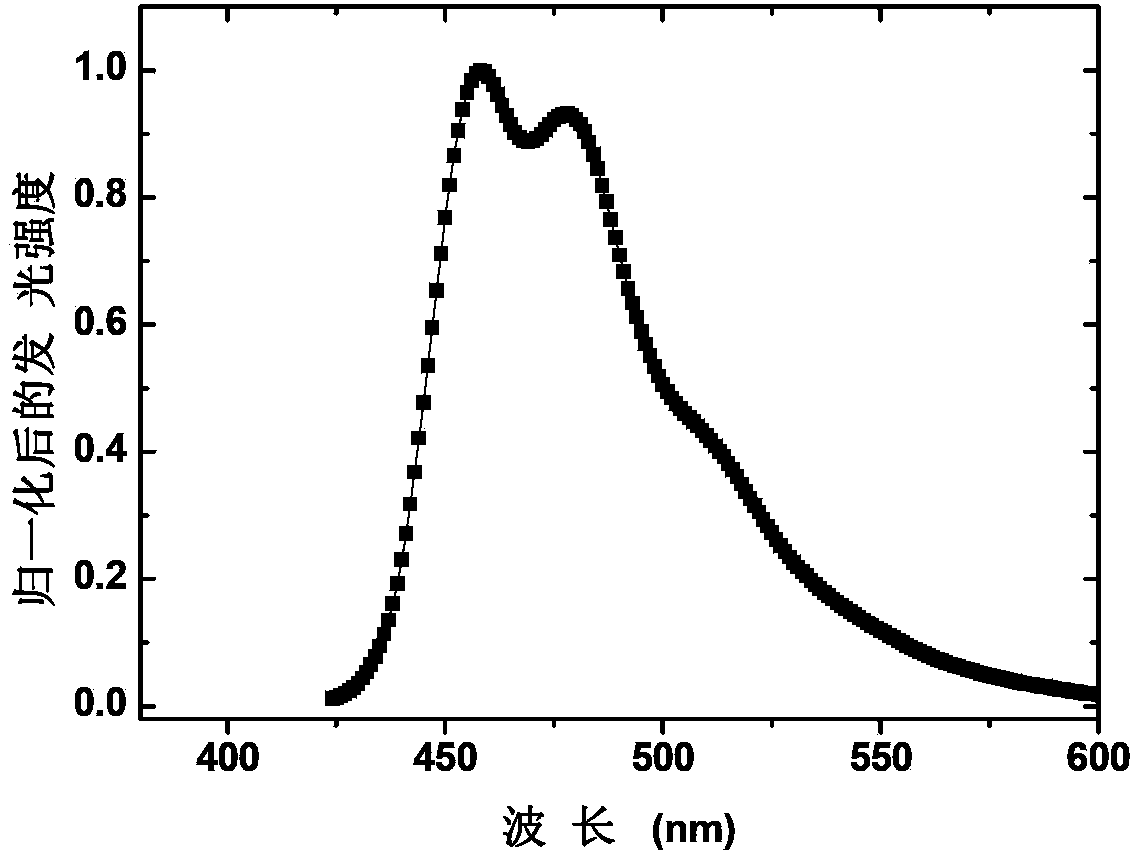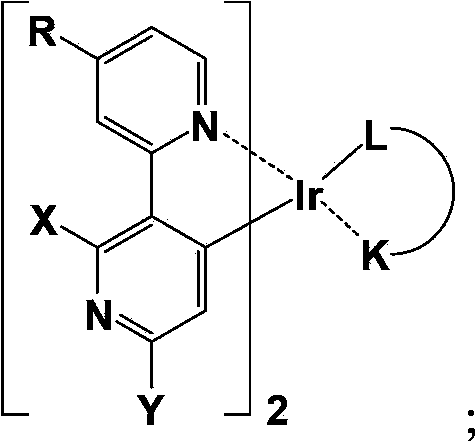Blue-light organic electrophosphorescence material, and preparation method and application thereof
A phosphorescent material and electromechanical technology, applied in the direction of luminescent materials, organic chemistry, chemical instruments and methods, etc., to achieve the effect of easy-to-obtain raw materials, mild reaction conditions, and mature technology
- Summary
- Abstract
- Description
- Claims
- Application Information
AI Technical Summary
Problems solved by technology
Method used
Image
Examples
preparation example Construction
[0045] The preparation method of the above-mentioned blue light organic electrophosphorescent material comprises the following steps:
[0046] S1, under the protection of an inert gas (the inert gas of the present invention includes nitrogen, argon or a mixed gas of nitrogen and argon, similar to the following), the structural formula is Compound D (when R is H, it is named 2-bromopyridine; when R is alkyl, it is named 4-alkyl-2-bromopyridine; when R is alkoxy, it is named 4-alkoxy-2- Bromopyridine) and the structural formula is Compound A (according to X and Y being C1 or F independently of each other, its naming will be different, please refer to each example for specific naming) is added to the first solvent containing the base and the catalyst according to the molar ratio of 1:1.2, Obtain a mixed solution, then heat the mixed solution to 100°C, stir the reaction for 20h, and cool to room temperature to obtain the structural formula: Compound B (according to X and Y be...
Embodiment 1
[0066] The blue-light organic electrophosphorescent material of this embodiment, that is, bis(2',6'-dichloro-2,3'-bipyridine-N,C 2 ’) (2-pyridinecarbonyl) iridium
[0067] (1) Synthesis of 2,6-dichloro-3,2'-bipyridine
[0068] Under nitrogen protection, (0.95g, 6.00mmol) 2-bromopyridine, (1.38g, 7.20mmol) 2,6-dichloro-3-pyridineboronic acid, (3.04g, 22mmol) K 2 CO 3 and (0.35g,0.30mmol)Pd(PPh 3 ) 4 Dissolve in a mixed solution of 30mL toluene and 5mL water, heat to 100°C, and stir for 20h. After cooling to room temperature, the aqueous phase in the reaction mixture was separated and extracted three times with 100 mL of ethyl acetate, and the organic phases were combined. The combined organic phases were washed with brine and dried over anhydrous magnesium sulfate. Filter and evaporate the solvent to obtain the crude product. The mixture of chloroform and n-hexane with a volume ratio of 1:3 was used as the eluent for silica gel column chromatography to obtain 0.90 g of a...
Embodiment 2
[0084] The blue-light organic electrophosphorescent material of this embodiment, that is, bis(2',6'-difluoro-2,4'-bipyridine-N,C 2 ') (boron tetrapyrazolide) iridium
[0085] (1) Synthetic steps of 2,6-dichloro-3,2'-bipyridine
[0086] This step is identical with the step (1) of embodiment 1;
[0087] (2) Ligand is the synthesis step of the iridium-containing dichloro dimer of 2,6-dichloro-3,2'-bipyridine
[0088] This step is identical with the step (2) of embodiment 1;
[0089] (3) Synthesis of complex bis(2',6'-difluoro-2,4'-bipyridine-N,C2')(tetrapyrazolide boron) iridium
[0090] Under nitrogen protection, 50mL of methanol solution containing 0.81g (3.15mmol) AgOTf was slowly added dropwise to 60mL of iridium-containing bispyridine containing 2.03g (1.5mmol) of ligand 2,6-dichloro-3,2'-bipyridine Chlorine dimer in dichloromethane solution, stirring reaction at room temperature for 2h. Centrifuge to remove AgCl to obtain a clear solution, and rotary evaporate to remov...
PUM
| Property | Measurement | Unit |
|---|---|---|
| thickness | aaaaa | aaaaa |
Abstract
Description
Claims
Application Information
 Login to View More
Login to View More - R&D
- Intellectual Property
- Life Sciences
- Materials
- Tech Scout
- Unparalleled Data Quality
- Higher Quality Content
- 60% Fewer Hallucinations
Browse by: Latest US Patents, China's latest patents, Technical Efficacy Thesaurus, Application Domain, Technology Topic, Popular Technical Reports.
© 2025 PatSnap. All rights reserved.Legal|Privacy policy|Modern Slavery Act Transparency Statement|Sitemap|About US| Contact US: help@patsnap.com



